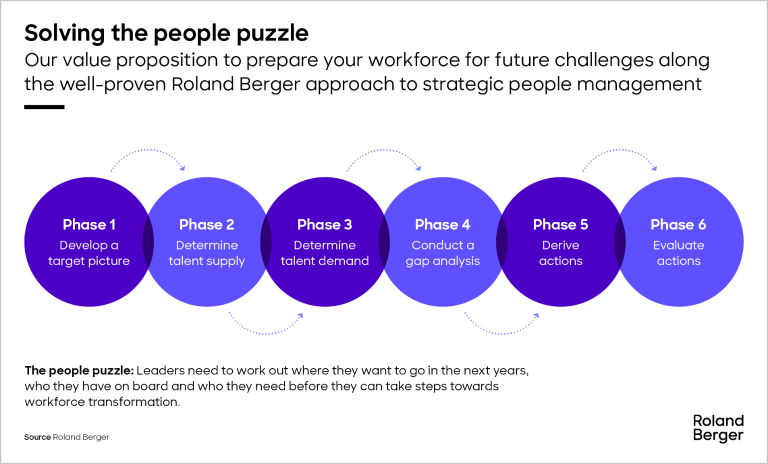Sign up for this issue of Think:Act Ideas for Action.


Solving the people puzzle
By Volker Rothfuss and Nina Feuersinger
Bridge the talent gap and shape your people base for success
One of the most pressing challenges facing C-suites is how to navigate a rapidly changing business world. The difficult macro-economic environment, pressure on supply chains, technological shifts, demographic change and growing sustainability concerns are forcing managers to rethink their visions, strategies and business models. Strategic people management has evolved into a key task for companies that want to implement strategy and stay competitive. Having the right people with the right skills on board is now more important than ever.

But how can company leaders predict what skills the organization may require in the future? How can they solve the "people puzzle" – determining which direction they want to steer their business in, and assessing which roles and skills the company will need in order to do so?
To help them master the challenge, Roland Berger has developed a unique six-step approach. We have used this methodology in various industries to great success. With the help of our expertise in transformation processes, we can effectively support your workforce transformation from end to end.
Phase 1: Develop a target picture
Based on a 360° assessment of the market, competition, customer expectations and internal operations, we work closely with your top management to develop a strategic target picture. This sets the overall direction. We then help you break down this target picture into individual strategic initiatives.
Phase 2: Determine talent supply
To determine current and future workforce supply, we collect information on existing employees, roles and staff qualifications. We then translate this into talent supply, taking into account company-specific parameters such as fluctuation, recruiting and productivity. We work closely with your HR department, tailoring our model to your specific requirements and data landscape.
Phase 3: Determine talent demand
Linked to the strategic target picture of the organization (Phase 1), we consider both internal and external drivers to determine, what talent you will need in the future. Internal drivers relate to the company's strategic considerations, such as digitization and partnerships; external drivers relate to the market and regulatory environment. We use our best-in-class tools and work with leading tech partners to develop a number of different scenarios for exactly which future roles and skills the organization will need.
Phase 4: Conduct a gap analysis
We can now determine the gap between supply and demand. For each role that we identify we help you create a job heatmap, illustrating the expected availability of business-critical talent in the coming years. We use our tried-and-tested quantification model to develop a skills-oriented people roadmap, which serves as the basis for future actions.
Phase 5: Derive actions
We develop recommended actions for each role, the aim of which is to close any gaps and eliminate surpluses. These actions are presented in the form of a strategic workforce planning handbook. Actions can include requalification, redeployment, recruitment, outsourcing and reduction. Of these, requalification is the most sustainable and so forms the heart of our approach. We draw on our global network of leading requalification partners and academies to create a structured training program tailored to the specific needs of your organization.
Phase 6: Evaluate actions
Finally, we continuously evaluate the effectiveness and quality of all implemented actions. We conduct regular pulse checks to identify potential risks and – if actions defer from the goal – closely align with top management to define appropriate countermeasures. In doing so, we ensure steerability and transparency during the implementation of actions.
Strategic workforce transformation with Roland Berger
At Roland Berger, we can help you solve the people puzzle. We have a very strong track record supporting clients in different industries, helping them achieve transparency over their talent supply and demand, predict their future requirements, develop actions to close the talent gap – and put those actions into practice.
Please contact us to find out more about our tools and methodologies or to discuss your specific situation.




_tile_teaser_w425x260.jpg?v=844690)

